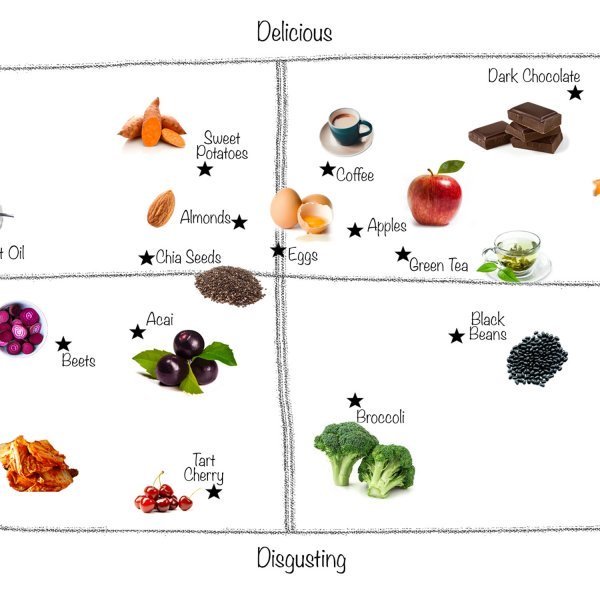
We talk about metabolism like it’s something we can manipulate by gulping a pill, downing some green tea, or running faster. You’ve seen the articles headlined “Boost your metabolism” or “Try this high-metabolism diet to lose weight.”
But this obscures many truths about this essential, yet still somewhat mysterious, biological process.
Here are nine facts to help you understand metabolism, and how to think about it in the context of weight gain and weight loss.
1) Your metabolism is in every cell in your body

Contribution of organs and tissues to bodyweight and basal metabolic rate.European Childhood Obesity Group
A lot of people talk about their metabolism like it’s a muscle or organ that they can flex or somehow control.
But in reality, your metabolism refers to a series of chemical processes in each cell that turn the calories you eat into fuel to keep you alive, said Michael Jensen, a researcher who studies obesity and metabolism at the Mayo Clinic. Your “basal” metabolic rate measures how many calories you burn while you’re doing nothing, he added. “It’s the culmination of different tissues with different needs and how many calories it takes to keep them functioning,” he said.
The body’s major organs — the brain, liver, kidneys, and heart — account for about half of the energy burned at rest, while fat, the digestive system, and especially the body’s muscles account for the rest.
You Might Also Like:
2) Most of the energy you burn is from your resting metabolism
There are three main ways your body burns energy each day: 1) the basal metabolism — energy used for your body’s basic functioning while at rest; 2) the energy used to break down food (also known as the thermic effect of food); and 3) the energy used in physical activity.
As we explored in a feature, one very underappreciated fact about the body is that your resting metabolism accounts for a huge amount of the total calories you burn each day. Physical activity, on the other hand, accounts for a tiny part of your total energy expenditure — about 10 to 30 percent (unless you’re a professional athlete or have a highly physically demanding job). Digesting food accounts for about 10 percent.

“It’s generally accepted that for most people, the basal metabolic rate accounts for 60 to 80 percent of total energy expenditure,” Alexxai Kravitz, a neuroscientist and obesity researcher at the National Institutes of Health, told me.
“It’s not nothing, but it’s not nearly equal to food intake, which accounts for 100 percent of the energy intake of the body,” Kravitz added. “This is why it’s not so surprising that exercise leads to [statistically] significant, but small, changes in weight.”
3) Metabolism can vary a lot between people, and researchers don’t understand why
It’s true that two people with the same size and body composition can have different metabolic rates. One can consume a huge meal and gain no weight, while the other has to carefully count calories to not gain weight.
But why this is remains a “black box,” said Will Wong, a researcher and professor at the Johns Hopkins Center for Metabolism and Obesity Research. “We don’t understand the mechanism that controls a person’s metabolism.”
Researchers have found some predictors of how fast a person’s metabolism will be. These include: the amount of lean muscle and fat tissue in the body, age, and genetics (though researchers don’t know why some families have higher or lower metabolic rates).
Sex also matters, since women with any given body composition and age burn fewer calories than comparable men. For women, Jensen added, “There’s a bit of an effect of menstrual cycle: Some women have a higher metabolic rate during the last half of menstrual cycle (during the luteal phase) when the resting metabolic rate in some women is up to 10 percent higher.”
You can’t easily measure your resting metabolic rate in a precise way (there are some commercially available tests, but the best measurements come from research studies that use expensive equipment like a metabolic chamber). But you can get a rough estimate of your resting metabolic rate by plugging some basic variables into online calculators (like this one). It’ll tell you how many calories you’re expected to burn each day, and if you eat that many and your weight stays the same, it’s probably correct.
4) Another thing that slows down the metabolism: getting older
The effect happens gradually, even if you have the same amount of fat and muscle tissue. So when you’re 60, you burn fewer calories at rest than when you’re 20.
Jensen said this continual decline starts as young as age 18 — and why this happens is also another metabolism question researchers haven’t answered. “Why does your energy needs go down as you age even if you keep everything else pretty much the same — that’s one of the bigger mysteries we have.”
5) You can’t really speed your metabolism up for weight loss

There’s a lot of hype around “speeding up your metabolism” and losing weight by exercising more to build muscle, eating different foods, or taking supplements. But it’s a metabolism myth.
While there are certain foods — like coffee, chili, and other spices — that may speed the basal metabolic rate up just a little, the change is so negligible and short-lived, it would never have an impact on your waistline, said Jensen.
Building more muscles, however, can be marginally more helpful. Here’s why: One of the variables that affect your resting metabolic rate is the amount of lean muscle you have. At any given weight, the more muscle on your body, and the less fat, the higher your metabolic rate. That’s because muscle uses a lot more energy than fat while at rest (see the graphic in section one).
So the logic is if you can build up your muscle, and reduce your body fat, you’ll have a higher resting metabolism and more quickly burn the fuel in your body.
But there’s a caveat, said Michael Rosenbaum, a Columbia University professor and researcher who studies weight loss and metabolism: “If you have more muscle, it burns fuel more rapidly. But that’s only half the question.” If you do gain more muscle and effectively speed up your metabolism, “you have to fight the natural tendency to [want to] eat more as a result of your higher metabolism.”
Jensen also noted that it’s difficult for people to sustain the workouts required to keep the muscle mass they gained. “For most people, it’s kind of impractical,” he added.
Overall, he said, “There’s not any part of the resting metabolism that you have a huge amount of control over. The control tends to be relatively modest, and unfortunately, it also tends to be on the downside.”
You Might Also Like:
6) Dieting can slow down your metabolism
While it’s extremely hard to speed the metabolic rate up, researchers have found there are things people do can slow it down — like drastic weight loss programs.
“[Crash diets] are probably the biggest effect we have on resting metabolism,” said Jensen. “Unfortunately, it’s not in a direction we want to go in.”
For years, researchers have been documenting a phenomenon called “metabolic adaptation” or “adaptive thermogenesis”: As people lose weight, their basal metabolic rate — the energy used for basic functioning when the body is at rest — actually slows down to a greater degree than would be expected from the weight loss.
To be clear: It makes sense that losing weight will slow down the metabolism a bit, since slimming down generally involves muscle loss, and the body is then smaller and doesn’t have to work as hard every minute to keep running. But the slowdown after weight loss, researchers have found, often appears to be substantially greater than makes sense for a person’s new body size.
In a scientific study published in the journal Obesity, researchers at NIH followed up with contestants from season eight of the reality TV show The Biggest Loser. By the end of the show, all of the participants had lost dozens of pounds, so they were the perfect study subjects to find out what happens when you lose a dramatic amount of weight in a short period of time.
The researchers took a number of measurements — bodyweight, fat, metabolism, hormones — at both the end of the 30-week competition in 2009 and again, six years later, in 2015.

Though all the contestants lost dozens of pounds through diet and exercise at the end of the show, six years later, their waistlines had largely rebounded. Thirteen of the 14 contestants in the study put a significant amount of weight back on, and four contestants are even heavier today compared with before they went on the show.
But the participants’ metabolisms had vastly slowed down through the study period. Their bodies were essentially burning about 500 calories fewer (about a meal’s worth) on average each day than would be expected given their weight. And this effect lasted six years later, despite the fact that most participants were slowly regaining the weight they lost.
Sandra Aamodt, a neuroscientist and author of the book Why Diets Make Us Fat, explained this may be the body’s way of vigorously defending a certain weight range, called the set point.
Once you gain weight, and keep that weight on for a period of time, the body can get used to its new, larger size. When that weight drops, a bunch of subtle changes kick in — to the hormone levels, the brain — slowing the resting metabolism, and having the effect of increasing hunger and decreasing satiety from food, all in a seeming conspiracy to get the body back up to that set point weight.
In the Biggest Loser study, for example, the researchers found each participant experienced significant reductions in the hormone leptin in their bloodstreams. Leptin is one of the key hormones that regulate hunger in the body. By the end of the Biggest Loser competition, the contestants had almost entirely drained their leptin levels, leaving them hungry all the time. At the six-year mark, their leptin levels rebounded — but only to about 60 percent of their original levels before going on the show.
“I don’t think that most people appreciate how big these metabolic changes can be when people lose a lot of weight,” Aarmodt said. “Weight gain and loss are not symmetrical: The body fights much more strongly to keep weight from dropping than it does to keep weight from increasing.”
But not every kind of weight loss in every person results in such devastating metabolic slowdown. For example: That great effect on leptin seen in the Biggest Loser study doesn’t seem to happen with surgically induced weight loss.
Indeed, all the researchers I spoke to thought the effects in the Biggest Loser study were particularly extreme, and perhaps not generalizable to most people’s experiences. (That makes sense, since the study involved only 14 people losing vast amounts of weight on what amounts to a crash diet and exercise program.)
The Mayo Clinic’s Jensen said he hasn’t found in his patients as dramatic a slowing of the metabolism in studies where people lose about 20 pounds over four months.
“We don’t really see that much of a drop in resting metabolism [as seen in the Biggest Loser study]. With slow, gradual weight loss, the metabolic rate holds out really well.”
7) Researchers don’t fully understand why this metabolic slowdown happens
There are some interesting hypotheses, however. One of the most persistent is an evolutionary explanation. “Over hundreds of millennia, we evolved in an environment where we had to confront frequent periods of undernutrition,” Columbia’s Rosenbaum said. “So you would predict that the human DNA would be full of genes that favor the storage of extra calories as fat. That ability would to some extent increase our ability to survive during periods of undernutrition, and increase our ability to reproduce — genetic survival.”
Today, the thinking goes, this inability to keep off weight that’s been gained is our body defending against periods of undernutrition, even though those are much rarer now.
But not all researchers agree with this so-called “thrifty gene” hypothesis. As epigeneticist John Speakman wrote in a 2013 analysis, one issue with the hypothesis is that not everybody in modern society is fat:
“If the thrifty alleles provide a strong selective advantage to survive famines, and famines have been with us for this period of time, then these alleles would have spread to fixation in the entire population. We would all have the thrifty alleles, and in modern society we would all be obese. Yet clearly we are not. Even in the most obese societies on earth, like the United States, there remain a number of individuals, comprising about 20% of the population, who are stubbornly lean. If famine provided a strong selective force for the spread of thrifty alleles, it is pertinent to ask how so many people managed to avoid inheriting these alleles.”
And, Rosenbaum added, “The evolution of our genetic predisposition to store fat is quite complex. It involves a frequently changing environment, interactions of specific genes with that environment, and even interactions between genes.” How this works exactly is still a mystery.
Researchers are also trying to better understand metabolic syndrome — the name given to a set of conditions including increased blood pressure, high blood sugar, a large waistline, and abnormal cholesterol or triglyceride levels. When people have several of these health issues, they’re at an increased risk of chronic health issues, including heart disease, stroke, and diabetes. Again, how this works and why it affects some people more than others remains unclear.
8) A slower metabolism doesn’t mean keeping weight off is futile
“Fifteen percent of people, on average, manage to lose 10 percent of their weight or more and keep it off,” Rosenbaum said. So weight loss is possible.
For any would-be weight loser, Rosenbaum said the key is finding lifestyle changes you can stick to over a long period of time, and viewing those as changes needed to keep a disease — obesity — under control. (You can read more advice from top weight loss doctors here.)
He pointed to the National Weight Control Registry, a study that has parsed the traits, habits, and behaviors of adults who have lost at least 30 pounds and kept it off for a minimum of one year — as an example of how they do that. The registry currently has more than 10,000 members enrolled in the study, and these folks respond to annual questionnaires about how they’ve managed to keep their weight down.
The people who have had success in losing weight have a few things in common: They weigh themselves at least once a week. They exercise regularly at varying degrees of intensity, with the most common exercise being walking. They restrict their calorie intake, stay away from high-fat foods, and watch their portion sizes. They also tend to eat breakfast.
But there’s a ton of diversity as to what makes up their meals. (So there is no “best” diet or fad diet that did the trick.) And they count calories.
“They made huge changes to diet and exercise plans to keep it off. It’s hard,” Rosenbaum said. “But I’d much rather have someone tell me I’m having trouble losing weight and keeping it off because I have a biological disease than … because I’m lazy and gluttonous.”
9) Bonus fun fact: Hummingbirds have the fastest metabolism in the animal kingdom

Researchers are looking at variety of animal models to see what they can tell us about the mysteries of the human metabolism.
Of particular interest is the hummingbird. “In the entire animal kingdom, among all the animals with a backbone, the one with the highest metabolic rate is the hummingbird,” said Johns Hopkins’s Wong. “They have a wing beat of 60 to 80 stokes per second.”
Interestingly, most of their diet comes from sugary sources like nectar, and they have a blood sugar level that would be considered diabetic in humans. But they manage to burn through it rapidly to keep their wings fluttering at top speed.





